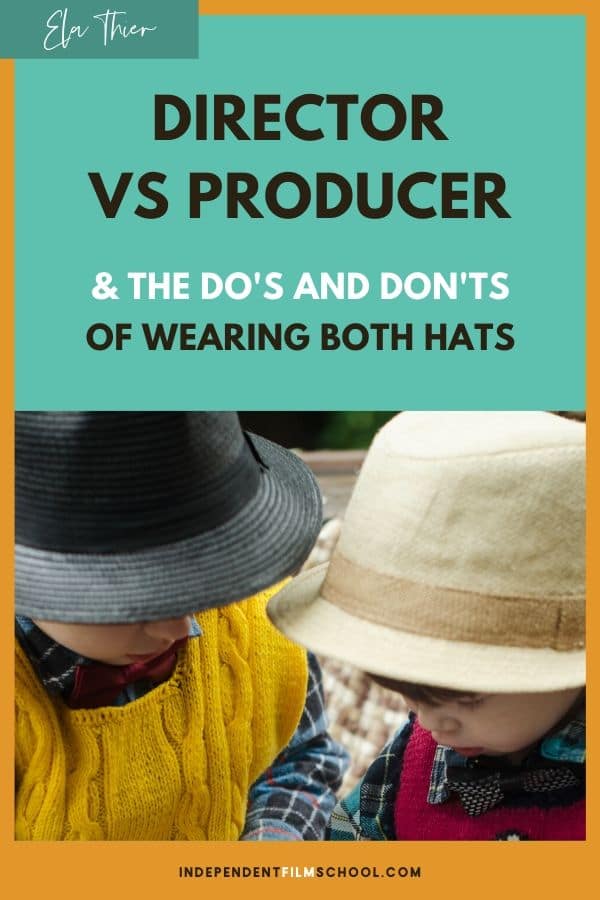
I was once pitching a film to a potential investor and he went off on me about being both a producer and a director on the project, and how no one should ever do that. Ever! (Take that M. Night Shyamalan! Never! Just watched Signs recently so I’m under the influence…)
Anyhoo, I told him that I agree, it’s not ideal. But then I asked him if I were a single mom making ends meet, would he yell at me for holding two jobs to feed my kids.
Seriously, if you’re an indie filmmaker, the decision to be both director and producer is hardly a decision. None of my films would have been made if I didn’t pull up my sleeves and make it happen. So let’s talk.
First, for those totally new to the work, let me not assume that you get what these folks even do:
What is the difference between director and producer? What do they actually do?
Producer, definition
The producer is the boss. This person assembles and runs the company. This is the person who finds, recruits, chooses, all the different pieces of the puzzle that together make a movie.
She may choose the script that you film. She may choose the lead cast members. She will hire every department head, and then support them to find and hire their departments. She will also choose the director.
Director, definition
The director is a hired crew members. The director is one of the pieces of the puzzles that the producer assembles. She works for the producer and is supervised and supported by her.
The director’s job on a film set is to come up with a creative vision that will be bring the script to life. Her job is also to communicate that vision effectively to the actors and department heads so that what’s in her head is what ends up on the screen.
See my article on: What is a Director’s Vision for help demystifying that whole rigamarole.
If she’s directing a series, her job is to know how to execute a directorial style that will remain seamless with the rest of the show so that you can’t tell that different people directed different episodes. She’ll know how to stick with the brand!
DIRECTOR VS PRODUCER: FRIENDS OR ENEMIES?
These two crew members have very different roles and each is absolutely necessary.
The producer is more of a managerial job, though great producers have excellent creative sensibilities. The director is a hired creative, though the great ones are great managers too.
A great producer, by definition, knows how to support the director
Because the producer is the one who assembles, supervises, (and pays!) the crew, they usually have creative control of the project.
But. And this is a big but. A great producer knows that if the creative vision becomes a tug-of-war between what they envision and what the director envisions, you end up with a mess.
A great film is born when a producer goes out of their way to support the work of the director. That means consulting and often deferring to the director in terms of who they hire, who they cast, and even how they allocate budget. (What should receive priority?)
The two collaborate with the common goal of creating the best possible film.
When a producer’s ego gets in the way, or they assert their vision over the director’s, you get a crappy film that is neither a product of their vision or the director’s vision.
When I’ve been hired to direct films that I didn’t produce, I always negotiated shared creative control.
When I’ve been hired to direct, I’ve made sure to share creative control with my boss (the producer!) This means that we both must approve the final shooting script, the cast, and the final cut of the film.
So how do you pull off being both producer and director and what are the pitfalls?
Before I continue, quick word from the sponsors (wait, that’s me!)
Join the thousands of screenwriters and filmmakers who’ve joined my (free!) membership for the many courtesy trainings and resources that I offer. Click below:
Director vs producer: how to pull off being both
The director on indie projects is often the best producer available.
As an independent filmmaker, by far most of the projects that I’ve directed I’ve also produced. As producer first and foremost, I get to choose who I want to hire as director. I was the director that I “hired.”
With all due respect to Mr. Money Bags who yelled at me for doing both jobs, let’s be real. If you’re the right person to direct your own project, you really do have to produce it as well.
No one will pound the pavement as hard as you will for the film. It’s your baby. Even if you don’t call yourself a producer, if the budget is not there to pay someone for endless hours of hard work, you will function as producer, don’t kid yourself.
Step 1: hire two more producers
Even if you’re not both director and producer, it’s common to have a team of 2-4 producers. When a film gets an Oscar for best picture, up to three producers, according to Academy regulations, can legitimately claim an Oscar. It’s really rare for a film to have less than three producers.
Usually, one of the three or more producers is the Grand Pooba. The boss of the other producers. (Not always the case, but usually.)
If you’re a director producing your own film, recruit two more producers. Make sure one of them is someone you will learn from. Make sure one of them adores you to the ends of the earth (you’ll need it) and will be willing to work crazy hard. And then remember that you’re the boss of the entire team.
Step 2: take your producing hat off shortly before the shoot and during the shoot itself.
Producing is an all-consuming job. Directing is an all-consuming job.
Mr. Money Bags who yelled at me wasn’t entirely wrong. He just never had to think creatively about how to make meager resources stretch like crazy.
So that’s how.
If you’re shooting a short, one week before the shoot take that producer hat off. Your inbox should become eerily quiet. You’re no longer figuring out logistics. You’re busy working with actors and your art director.
If you’re shooting a feature, take your producer hat off at least 2-3 weeks before the shoot. You’ll wear it again when the film is in the proverbial can and it’s time for post production.
Never ever produce while directing when you’re on set. That’s the kiss of death.
Producing and directing are each an all-consuming job on set, and they’re very different jobs.
One of you is turning the world upside down to track down a missing hard drive, while the other one is having laughs with an actor about what kind of shoes they’ll be wearing, utterly oblivious to the catastrophe of the missing hard drive.
A great producer knows how to create a “bubble of oblivion” around a director so that they’re completely hands off logistics and are completely focused on their creative vision.
If you try to be both director and producer on set, you will end up producing, and there won’t be a director on set.
Mark. My. Words.
Once the film is in the can you’ll put your producer hat back on and get back to pounding the pavement.
You need time during pre-production and, and you need every second available during the shoot itself, to be solely focused on planning your shots, the art design, and most importantly, your actors’ performances.
All of the above will be compromised if you’re getting emails about the cost of renting walkies and how you’ll deal with the sound guy’s peanut allergies with all that peanut butter that had been donated to the crafts table. (Who can turn down a food donation?! Not us!)
Be clear about the time table with your producing partners
Talk to your two producing partners about this in advance. Let them know that you’ll haul ass as producer along side them up until such-and-such date.
Up until that point, be the hardest working and best producer on the team. It’s on you to knock on doors, raise the money, hustle those favors, talk to Aunt Sally about donating all that peanut butter.
But on that date that your team has agreed you would take that hat off, you’ll need to be “director only”.
You should all have this date in your calendar. You agree together that from that date on and up until the film is in the can, your inbox will be silent. Your producing partners will see to it that the crew comes to them, and them only, with any issues related to production. What comes to you are directorial questions only.
If you’re directing a short, take your producing hat roughly one week before the shoot. If you’re directing a feature, take your hat off at least two to three weeks before production.
When the day comes that you all agreed on, you’ll be rehearsing with your actors. When you instinctually reach for your phone to see what fires need to be put out, your quiet inbox and the lack of opportunities to multi-task will send shivers down your busy spine. There’ll be nothing in your inbox other than that note from the art director about what color scrubs you want for the nurse character.
Now we have a director on set.
You can put the producer hat back on and sigh with relief as your inbox explodes, only when the film is in the can and it’s time for post-production.
Producer vs Director: a necessary tug-of-war.
The difference between director & producer creates an important tension.
The producer and director have opposing jobs, and this symbiotic relationship creates an important balance.
The producer, by definition, must conserve. Their job is to ensure that everything happen on time and on budget.
The director’s job is to dream big and be extravagant.
If the producer is directing, they’ll spend more than they have. If the director is producing, they’ll reign in their creativity when the film needs it. The tug-of-war between the producer and the director is necessary and healthy.
My experience as director and producer on my film Foreign Letters.
My producer, Inna Braude, says that she felt it starkly on the day I took my producer hat off when we were in pre-production on Foreign Letters.
All of a sudden I was arguing about wanting more background actors on set, when up till that point I was counting, conserving and stretching every penny. According to her, I turned into a different person overnight. As it should be.
I got fewer extras than I wanted, by the way, and she provided more extras than she had hoped we would use. As it should be. That’s exactly the tug-of-war that you will need.
Good producers, with the help of the assistant director, create a bubble of “cluelessness” around the director.
The director becomes utterly oblivious to all-things-production, even though they’re the grand pooba producer who put the whole team together.
Someone broke the side-view-mirror of the truck, they still haven’t tracked down that hard drive, the food isn’t arriving, an angry neighbor is calling the cops, three PA’s called in “sick” that morning, and the director is taking her sweet time going over the emotional beats of a performance with her actor because she has no idea that any of that is happening.
She’ll get to hear the war stories at the wrap party, which she doesn’t know yet we can no longer afford. Let your two producers know that this is what you’ll need from them in order to pull off directing a film you’re producing.
Nothing wrong with being both producer and director. Just don’t it during the shoot itself. Please.
Try to produce and direct at the same time on set, and you’ll regret doing that every time you watch the film because you’ll notice all the things you didn’t address as a director while you were figuring out the rental price of walkies.
See you at the movies!
Ela
Join my free training for directors: The Ultimate Shot Planning Crash Course!




1 thought on “Director vs Producer – Difference between director and producer, and how to be both when you have to”